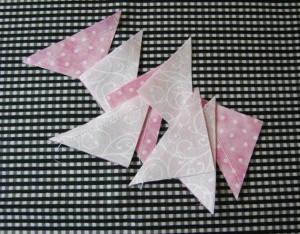This year we will stepping out into new ideas and techniques. First, we will be having a series of Lessons on Color Theory for Fiber Artists, where we will dig a little deeper into many aspects of color. This will be relevant whether you knit, crochet or quilt!
Next, we’ll have a series of Lessons on Triangles, which will be working with triangles in quilt blocks. Our first lesson will start off with just learning how to make triangles, and how you can rearrange them to make different patterns. Throughout the year, we will ‘play’ with other ways to combine triangles and squares to make different kinds of quilt blocks. At the end of the year, you will be able to make a Sampler Quilt, where each block is different. We’re starting with Cheryl’s Half Square Triangle Adventure.
Then, we’ll look at several playful and fun Crochet Stitches you can use to add pizzazz to anything you crochet.
Remember those beautiful Bookmarks we made last year? Well, the women at Wheeler loved them! We will be having a Lesson on Bookmarks later in the Spring! Not just ‘Scrapbook’ style, but also crochet, quilted, and whatever other ideas we (or You) come up with!
Our Crafting Workshop will meet on February 14th from 9:30 am to 2:00 pm. Remember to bring your lunch and all the materials and supplies you will need!
Color Theory for Fiber Artists – Part One
In February, Teresa is teaching part one of color theory for fiber artists. A huge amount of information on color theory is available for many types of artists, but for the fiber artists, not as much. For those who work in yarn, almost nothing is available. We will be covering the meaning of hue, tone, saturation, tint, shade, lightness, and value, along with an introduction to the fiber artist’s color wheel.
Half Square Triangle Adventure
Half-square triangles are begging to be explored. I know this is true, because a part of my stash with the addition of many yards of donated fabric have magically become a large pile of 14-inch squares.
You can find the tutorial pattern from Chez Stitches: Here or Here. There’s also a similar tutorial from Sew Mama Sew: Here.
What you need to bring:
- Six fourteen-inch squares each of “light” and “dark” cotton fabric.
- Fabric for borders, binding, and backing.
- One crib-sized cotton batting—45”x60” (the type that can be quilted up to 8 inches apart)
- Thread, Rotary cutter, Cutting Mat, Acrylic Ruler
- Sewing machine
One “light” and one “dark” square will be paired, which creates a high contrast. “Light” & “medium” and “medium” & “dark” combinations may also be used, which will result in a lower contrast quilt. Whatever way you choose will create a beautiful blanket.
There are approximately 12 “kits” available. The “kits” include most of the fabric supplies, but help will be needed to provide enough batting. Some are made from two fabrics only, and others have a variety of fabrics. Any square between 13 1/2” and 15” will work for this project. When all of the squares are made, trim them all to the same size within your own project. The size of your trimmed blocks will be somewhere between six and seven inches, depending on your individual sewing and cutting.
Crochet Lesson
The Bobble Stitch: A Texture Stitch in Crochet
The Bobble Stitch gives a nice, bumpy texture to crocheted ‘fabric.’ By working bobbles close together, a deeply textured surface is created. By combining the bumpy bobbles with smoother double crochet, an interesting effect emerges in pattern and design. Use the Bobble Stitch to make hats, scarves, baby blankets, and prayer shawls that you just have to touch and have eye appeal. The Bobble Stitch adds texture and pizazz to hats and scarves, and is an interesting touch for baby blankets, shawls, and even headbands/ear warmers. The bobbles are like bubbles that do not pop!
Color recommendation: select a variegated yarn for Color B; for Colors A (main color) and C (accent color), select two solid colors (match colors in the variegated yarn). Choose your variegated color first for Color B; then, since the hat is mostly Color A (solid color), decide on a contrasting yarn. The hat uses colors A & B; the scarf uses all three colors, so Color C should complement A and B.
You will need to bring:
Worsted weight (Group 4) yarn in three colors:
– Color A (main color) – 6 ounces
– Colors B and C (contrasting colors) – 4 ounces of each color
Size H/8 and size I/9 crochet hooks
Scissors
Yarn needle